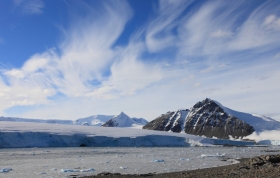Antarctica Ice Sheet less stable than previously thought

Earth continues to hit temperature and greenhouse gas milestones—just a couple of months ago, multiple stations measured carbon dioxide concentrations in the atmosphere of 400 parts per million, the highest in several million years. Many studies have tried to estimate how much and how rapidly the two great ice sheets covering Greenland and Antarctica might melt—and the one reassuring point has been the apparent relative stability of the eastern (and, by far, larger) half of the Antarctic Ice Sheet. Now, a new study of past melting in East Antarctica suggests that over the long haul, the "stable" ice sheet may be more vulnerable to warming than thought.
To study possible future melting of the ice sheets, many scientists look to the past. Current warm temperatures and high greenhouse gas conditions are reminiscent of the warm Pliocene Epoch that lasted from 5.3 million to 2.6 million years ago. "Early and middle Pliocene global temperatures and greenhouse gas concentrations are probably the closest analog in Earth's history to the present climate on this planet and the climate conditions we will encounter before the end of this century," says Claus-Dieter Hillenbrand, a sedimentologist at the British Antarctic Survey in Cambridge, U.K., who was not involved in the study.
Abundant studies have examined melting of the Greenland Ice Sheet and the West Antarctic Ice Sheet (WAIS)—long considered the more vulnerable portion of the continent's ice, as much of it lies below sea level, flowing seamlessly into floating ice shelves. Satellite observations reveal that the WAIS is losing mass, sped up by melting along the base of the floating portions as the oceans warm. But the East Antarctic Ice Sheet (EAIS), which lies primarily on land, has appeared considerably more stable.
Yet, data from the Pliocene tell a different story, says Carys Cook, a doctoral student at Imperial College London. Mean temperatures from the Pliocene were 2°C to 3°C warmer than today, and atmospheric carbon dioxide concentrations between 350 and 450 parts per million. Some data have also suggested that sea levels were perhaps 22 meters higher than today—and even complete melting of the WAIS and Greenland couldn't account for more than about 12 meters of that, Cook says. Melting of the EAIS would have to have contributed.
To get a better sense of how much melting might have occurred in East Antarctica during the Pliocene, Cook and her colleagues studied sediments from a deep marine core about 300 kilometers off the coast of Adélie Land in East Antarctica. The core, drilled in 2009 by the Integrated Ocean Drilling Program (IODP), included a long section of sediments dated to the Pliocene between 5.3 million and 3.3 million years ago. These sediments, the team found, told a story of continental erosion patterns as the climate warmed and cooled throughout the epoch.
In those sediments, the team looked for geochemical "fingerprints"—specifically, geochemical ratios of neodymium to strontium isotopes—that would help them identify the provenances, or sources, of the different layers of sediments. What they found in the Pliocene sediments was telling: They identified multiple layers containing a unique fingerprint for a large, low-lying part of East Antarctica known as the Wilkes Subglacial Basin, which is now ice-covered. For those sediments to have eroded and ended up offshore in the marine core, the basin would have had to be exposed by retreat of the ice, the team reports today in Nature Geoscience.
This does suggest that the East Antarctic Ice Sheet may not be as stable in a warm climate as some models suggest, Hillenbrand says. And, given that it indicates that the Pliocene had both ice-free warm periods and glacial periods, it's an "interesting alternative scenario" to the more extreme reconstructions that suggest either widespread melting across East Antarctica or no melting at all relative to today.
Still, just how sensitive East Antarctic ice is to warming temperatures remains the looming question, he adds. "The temporal resolution of the record does not allow them to conclude—or exclude—that the [ice] retreat occurred on centennial or millennial timescales."
It's a point that Cook acknowledges. "With our current data set, we don't know how quickly these retreat events took place," she says—or whether they occurred each time the Pliocene warmed. It may be that the ice repeatedly scoured the basin as it retreated or advanced; alternatively the basin may have been completely exposed for long periods of time. One way to try to answer these questions will be to resample the IODP core at higher resolutions, in order to track the transitions between ice-sheet retreat and no retreat.
More cores would be even better—the reason that the vulnerability of East Antarctica has been uncertain is probably simply a lack of information, and not just from the land, she adds. "We need marine sediments, we need to drill these deep sediment cores. The real records that tell us about erosional processes are the marine sediment-based records."
Antarctic landscape image via Shutterstock.
Read more at Science.
http://news.sciencemag.org/sciencenow/2013/07/east-antarcticas-ice-sheet-not-a.html?rss=1